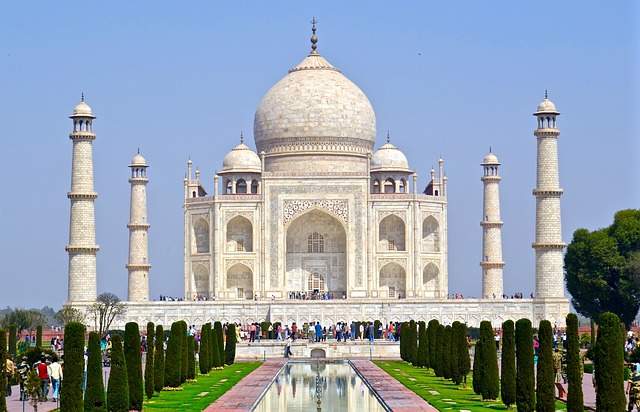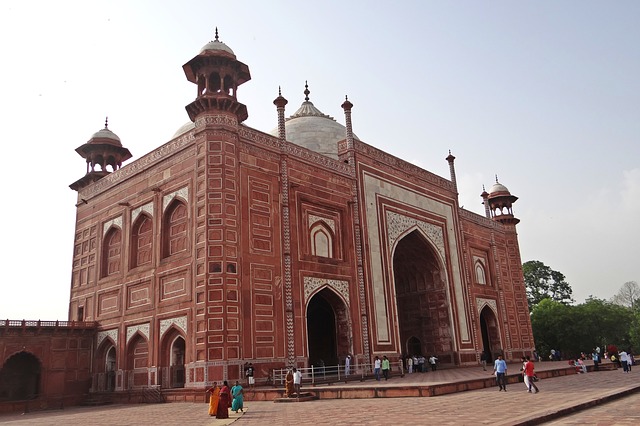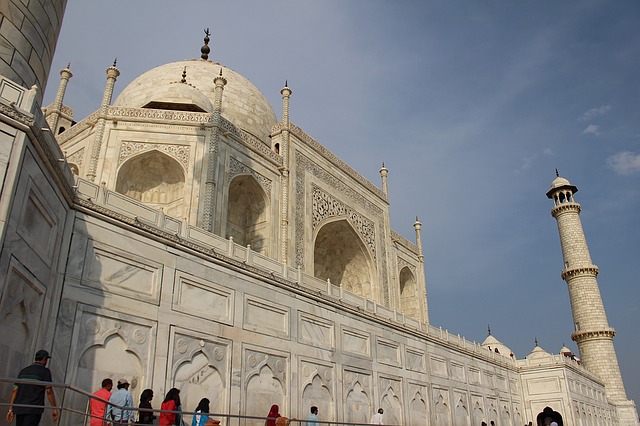Taj Mahal
Contents |
[edit] Introduction
The Taj Mahal is an ivory-white marble mausoleum located on the south bank of the Yamuna river in the Indian city of Agra. As a national symbol of India it is one of the most recognisible buildings in the world. The complex is actually made up of several buildings and gardens extending over 55.5 acres.
It was commissioned in 1632 by the Mughal emperor Shah Jahan to house the tomb of his favourite wife Mumtaz Mahal who died during childbirth. It was designed by Ustad Ahmad Lahauri, and is generally regarded as the best example of Mughal architecture, which is a blend of Indian, Persian and Islamic styles.
The architectural principles the Taj Mahal encapsulates include:
- Rational and strict geometry.
- Perfect symmetrical planning.
- Hierarchical grading of materials, forms and colours.
- Triadic divisions bound together in proportional formulas.
- Uniformity of shapes.
- Sensuous attention to detail.
- Selective use of naturalism.
- Symbolism.
The construction of the mausoleum was completed in 1643, with the rest of the complex taking a further ten years and a cost estimated to be 32 million rupees (equivalent to approx. $827 m in 2015).
It was designated as a UNESCO World Heritage Site in 1983, described as 'the jewel of Muslim art in India and one of the universally admired masterpieces of the world's heritage'. It attracts around 7-8 million visitors a year and frequently tops polls listing the world's most admired or beautiful building.
[edit] Design and construction
The translucent white Makrana marble tomb of the Taj Mahal is positioned on a square plinth 7 m (23 ft) high. Its four facades are almost identical, each with a wide central arch rising to 33 m (108 ft) at its apex. The central dome is 73 m (240 ft) high and its finial and is surrounded by four smaller domes. Four minarets are positioned on each corner of the square plinth.
The mausoleum interior is organised around an octagonal marble chamber with low-relief carvings and precious stones.
Flanking the mausoleum are two symmetrically identical buildings, the east-facing mosque and its west-facing jawab. Both are built of red Sikri sandstone with marble-necked domes and architraves.
The garden is set out as a square quartered by long watercourses with walking paths, fountains and ornamental trees.
The southern end of the complex is marked by a wide red sandstone gateway with a recessed central arch that reaches a height of two-storeys.
Verses from the Quran are inscribed in calligraphy across many sections of the Taj Mahal, including the soaring arched entrance to the mausoleum. The size of the lettering increases according to its relative height and distance from the observer. This was used as a means of achieving a uniform appearance from the vantage point of the terrace.
The construction process involved 22,000 workers and artisans from all over central Asia and beyond. It is thought that over 1,000 elephants were used to transport building materials. Precious and semi-precious stones inlaid into the white marble include jade and crystal from China, turquoise from Tibet, Lapis lazuli from Afghanistan, sapphire from Sri Lanka, and carnelian from Arabia.
Common legend has it that the emperor had wanted an identical black marble mausoleum to be built in the complex, although this failed to transpire.
[edit] Post-construction
Over the centuries, the Taj Mahal was neglected and allowed to fall into disrepair. At the time of the 1857 Indian rebellion, British soldiers and government officials chiselled out many of the precious stones from its walls.
However, at the beginning of the 20th century, a major restoration project was carried out under the direction of the British Viceroy of India, Lord Curzon.
The building faced several threats during the 20th century, from Japanese air attacks during the Second World War which prompted the government to disguise it with scaffolding, and from anticipated air attacks during the India-Pakistan wars of 1965 and 1971.
Environmental pollution also became a threat. Air pollution and acid rain caused by nearby factories, oil refineries and traffic was discolouring the marble façade. The Indian government acted by establishing the Taj Trapezium Zone (TTZ), a 4,000 sq. mile area around the complex with strict emissions standards, forcing the closure of some foundries and the banning of motor vehicles.
More recently, the decline in groundwater level in the Yamuna river basin has raised concerns about the tomb's structural integrity. Cracks began to appear in 2010 and the minarets showed signs of tilting, leading to fears that the wooden foundation may be rotting due to water deficit.
The conservation debate continues in India, with tighter restrictions being put in place to prevent pollution damaging the complex further.
In May 2018, it was reported that the Indian Supreme Court had suggested that the Indian government and the Utter Pradesh state government seek international help to reverse the Taj Mahal's marble discolouration. This problem has been caused by insects that secrete a green substance, which have been attracted by algae from the Yamuna River.
Speaking to the Archaeological Survey of India, two members of the Indian Supreme Court were quoted as saying, “it is very serious. It seems you are helpless. It has to be saved. You can get help from experts from outside to assess the damage done and restore it.”
[edit] Related articles on Designing Buildings Wiki
- Architecture.
- Building of the week series.
- Conservation of the historic environment.
- Eiffel Tower.
- Fallingwater.
- Florence Cathedral.
- Golden Temple, Amritsar.
- Hagia Sophia.
- India looks at using plastic instead of sand.
- India needs to build more infrastructure fast. Here's how.
- Indian construction industry.
- Indian infrastructure.
- Leaning Tower of Pisa.
- Mahabat Maqbara, India.
- Mausoleum.
- Minaret.
- Palace of Westminster.
- Parthenon.
- Petronas Twin Towers.
- Roman Colosseum.
- Sagrada Familia.
- Shanghai Tower.
- St Pauls Cathedral.
- Sydney Opera House.
- The British Mosque: an architectural and social history.
- Types of dome.
- Vastu Shastra.
- Vrindavan Chandrodaya Mandir.
IHBC NewsBlog
Images from inside a Grade II listed hotel show the scale of its collapse
The Corbett Arms in Tywyn has fallen into serious disrepair.
Old Sarum fire in listed (& disputed) WW1 Hangar - Wiltshire Council has sought legal advice after fire engulfed a listed First World War hangar that was embroiled in a lengthy planning dispute.
UK Antarctic Heritage Trust launches ‘Virtual Visit’ website area
The Trust calls on people to 'Immerse yourself in our heritage – Making Antarctica Accessible'
Southend Council pledge to force Kursaal owners to maintain building
The Council has pledged to use ‘every tool in the toolbox’ if urgent repairs are not carried out.
HE’s Research Magazine publishes a major study of the heritage of England’s suburbs
The article traces the long evolution of an internal programme to research 200 years of suburban growth
IHBC Context 183 Wellbeing and Heritage published
The issue explores issues at the intersection of heritage and wellbeing.
SAVE celebrates 50 years of campaigning 1975-2025
SAVE Britain’s Heritage has announced events across the country to celebrate bringing new life to remarkable buildings.
IHBC Annual School 2025 - Shrewsbury 12-14 June
Themed Heritage in Context – Value: Plan: Change, join in-person or online.
200th Anniversary Celebration of the Modern Railway Planned
The Stockton & Darlington Railway opened on September 27, 1825.
Competence Framework Launched for Sustainability in the Built Environment
The Construction Industry Council (CIC) and the Edge have jointly published the framework.

















Comments